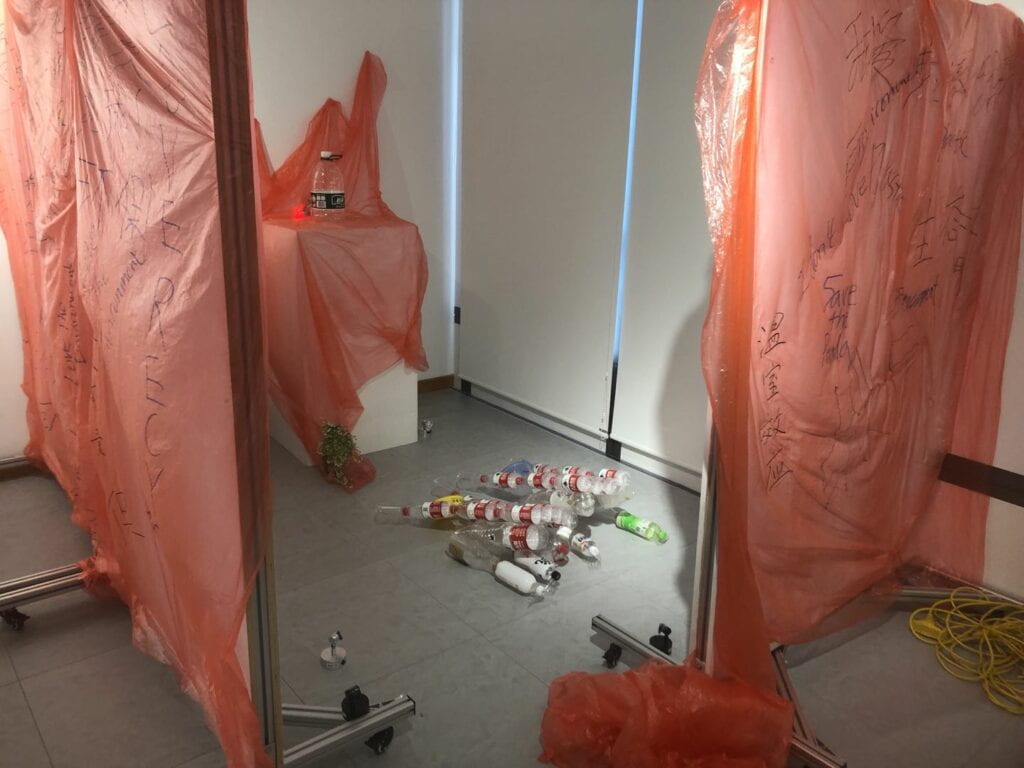Project Title: ECO
Medium: Art Installation (Plastic bottles and bags)
Artists: Ken Wu, Angela Zhang, and Huaze Shao
Artist Statement:
A plastic installation revolving around the worship of plastic was constructed to communicate the dualist nature of environmentalism as well as the hypocrisy of environmentalism. Being a covered space with words encouraging environment protection, there is a lack of transparency to view the installation to communicate a hidden reality of activists and society in general. While we publicly acknowledge and promote environmentalism, we still practice the usage and waste of plastic privately. To an extent, this practice of using plastic is similar to practicing a religion where plastic has become a core of daily life. In addition, we created this installation as something that is entered to signify the uncovering of the truth. This action would be a symbol of taking a step for awareness of plastic consumption.
Project Statement:
For the project, we were inspired by both our visit to the New Garden, research of worship of religion, and environmentalism. Firstly for our inspiration to the new garden, we were firstly inspired by the history of the garden. When we heard that there was a major trash issue from the neighborhood in the past, it drew us inspiration to represent this. Using first hand experience of our observations, we saw that there was an immense plastic issue in the community as well as a littering issue. This led us to focus on the topic of plastic consumption and usage. Furthermore, as the issue of plastic trash being most of the litter was apparent, we wanted to exemplify this in some manner. 
The act of entering this New Garden also drew inspiration for us where we created our installation to also include an entrance to mimic the entering of the garden space, a space that was previously filled with this plastic trash.

We also focused on researching religion as a major part of our research where we considered a lot of cultural practices in Chinese, Arabic, and Japanese culture. This would be the bowing practice that occurs in these cultures, where we especially focused on the Arabic pilgrimage and how they worshiped. This would inform us of the anatomy that we would incorporate for our piece where our usage of plastic bottles would mimic this worshiping pattern. We subsequently attributed plastic consumption to the worship of plastic.
 (Credit: Times of Israel)
(Credit: Times of Israel)
Furthermore, we also drew inspiration of color from Christianity color symbols where red represents blood (Times of Israel).
Lastly, we considered environmentalism especially in the context of NYU. While a lot of the community says that they support trying to be more eco-friendly, they still consume takeout, still waste food, and consume plastic. This essentially is reflected in our exterior of the space, saying that we love the world, our environment, but we still commit acts of plastic consumption which references the bowing to plastic.

Documentation







Conclusions
The goal of this project was to raise awareness regarding trash consumption through creating a spatial installation that revolved around revealing the true reality of environmentalism. While environmentalism is meant to protect the environment, the reality is that people are still consumers despite raising awareness. In this sense, we wanted to hide this act of worshiping plastic behind walls which would essentially represent the uncovering of this truth of trash consumption. This is further seen through the writing about protecting the environment on the walls.
When creating this project, we struggled a bit with the construction of the people. While we were able to make it, the figures were fragile and didn’t last until exhibition space as we had completed this days in advance. Furthermore, we struggled with not having enough material. While we wanted to create an entire red surrounding to show the nature of plastic as destructive as well as convey the feeling of a religious space. Despite not being able to create more permanent figures and making it more complete through the surrounding, this project was still overall successful since it did create something from plastic bottles to be one relating to religion. While we wanted to be more sensitive of religion where we didn’t create a more noticeable symbol such as a Buddha statue, the fact is that it still raised awareness of plastic as a religion. In conclusion, while the installation itself wasn’t constructed perfectly, it still served the purpose of promoting awareness and shifting a perspective on the role of plastic in our life.
Presentation and Proposed Solutions
Works Cited
Afp, et al. “2 Million Expected in Mecca for Hajj Pilgrimage, a Pillar of Islam.” The Times of Israel, 9 Aug. 2019, https://www.timesofisrael.com/2-million-expected-in-mecca-for-hajj-pilgrimage-a-pillar-of-islam/.
Leave a Reply